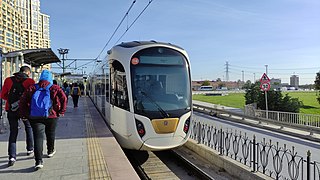
The Melbourne tramway network is a tramway system serving the city of Melbourne, Victoria, Australia. The tramway network is centred around the Melbourne central business district (CBD) and consists of approximately 1,700 tram stops across 24 routes. It is the largest operational urban tram network in the world and one of the most used, with more than 500 trams and 250 kilometres of double tram track. It served a patronage of 206 million over the year 2017-2018. Trams are the second most utilised form of public transport in Melbourne after the city's metropolitan commuter railway network.

The Alstom Citadis is a family of low-floor trams and light rail vehicles built by Alstom. As of 2017, over 2,300 Citadis trams have been sold and 1,800 tramways are in revenue service throughout the world, with operations in all six inhabited continents. An evolution of Alstom's earlier TFS vehicle, most Citadis vehicles are made in Alstom's factories in La Rochelle, Reichshoffen and Valenciennes, France, and in Barcelona, Spain, and Annaba, Algeria.

Yarra Trams is the trading name of the operator of the tram network in Melbourne, Australia, which is owned by VicTrack and leased to Yarra Trams by the Victorian Department of Transport and Planning. The current franchise is operated by Keolis Downer. As at May 2014, Yarra Trams operate 487 trams, across 26 tram routes and a free City Circle tourist tram, over 1,763 tram stops. With 250 km (155.3 mi) of double track, Melbourne's tram network is the largest in the world.

The D-class Melbourne tram is a fleet of low-floor Combino trams that operate on the Melbourne tram network. They were built by Siemens in Uerdingen, Krefeld, Germany, and are divided into two classes: the three section D1-class which was introduced between 2002 and 2004, and the five section D2-class which was introduced in 2004. The D-class was procured by M>Tram and have been operated by Yarra Trams since they took control of the entire tram network in April 2004.

Melbourne tram route 96 is operated by Yarra Trams on the Melbourne tram network from Brunswick East to St Kilda Beach. The 13.9 kilometre route is operated out of Southbank depot with C2, E class, and on occasion A class trams.

A low-floor tram is a tram that has no stairsteps between one or more entrances and part or all of the passenger cabin. The low-floor design improves the accessibility of the tram for the public, and also may provide larger windows and more airspace.

The B-class Melbourne tram is a class of two-section, three-bogie articulated class trams that operate on the Melbourne tram network. Following the introduction of two B1-class prototype trams in 1984 and 1985, a total of 130 B2-class trams were built by Comeng, Dandenong.

The Tramway Français Standard (TFS) is a type of tram designed and manufactured by Alstom for use on various tramway systems in France. The TFS is no longer in production, having been superseded by the Alstom Citadis range of tramcars.
The X'Trapolis 100 is a class of single deck electric multiple units part of Alstom's X'Trapolis family of trains, operated in Melbourne, Victoria, Australia and Valparaíso, Chile.

Brunswick tram depot is located on Sydney Road, Brunswick, a suburb of Melbourne, Victoria, Australia. It opened on 26 April 1936 in conjunction with the electrification of the Brunswick and North Melbourne Cable tram line. Operated by Yarra Trams, it is one of eight tram depots on the Melbourne tram network.

The C2-class trams are five-section Alstom Citadis 302 trams built in La Rochelle, France that operate on the Melbourne tram network. They were built for the tram network in Mulhouse, France, but being surplus to Mulhouse demands, were leased to use in Melbourne in 2008, later being purchased by the Government of Victoria. The trams operate solely on route 96.
Ballarat North Workshops is a railway engineering facility owned by Alstom in Ballarat, Victoria, Australia. It occupies 5.5 hectares of land beside the junction of the Mildura and Serviceton railway lines.

Metro Trains Melbourne, often known simply as Metro, is the operator and brand name of train services on the electrified metropolitan rail network serving the city of Melbourne, Victoria, Australia. It is the largest urban rail network in Australia, with 17 lines and 221 stations across 405 km (252 mi) of railways, and the second busiest network in Australia, with a patronage of 99.5 million as of 2021–2022.

The Istanbul Tram is a modern tram system on the European side of Istanbul. The first section, the T1 opened in 1992, followed by the T2, which opened in 2006. In 2011, the T1 and T2 merged, with the line retaining the T1 name. The T4, T5 and the T6 lines followed, opening in 2007, 2021 and 2024 respectively.

The Casablanca Tramway is a low-floor tram system in Casablanca, Morocco. As of 2019, it consists of two lines - T1 from Sidi Moumen to Lissasfa, and T2 from Sidi Bernoussi to Aïn Diab—which intersect at 2 points and form a 47 km (29 mi) network with 71 stations. Two additional lines, T3 and T4, are scheduled to open in 2024.

The E-class trams are three-section, four-bogie articulated trams that were first introduced to the Melbourne tram network in 2013, built at the Dandenong rolling stock factory of Bombardier Transportation with the propulsion systems and bogies coming from Bombardier/Alstom factories in Germany.

The T1, officially referred to as the T1 Kabataş–Bağcılar tram line is a tram line of the Istanbul Tram, operated by Metro Istanbul. It runs from Kabataş to Bağcılar via Eminönü, with a total length of 19.3 km (12.0 mi).

The Alstom Citadis Spirit is a low-floor articulated light rail vehicle developed by Alstom for Ottawa's O-Train. It is marketed as part of its Citadis family, which includes other models of light rail vehicles, and is based on the Citadis Dualis.
Trams have been used since the 19th century, and since then, there have been various uses and designs for trams around the world. This article covers the many design types, most notably the articulated, double-decker, drop-centre, low-floor, single ended, double-ended, rubber -tired, and tram-train; and the various uses of trams, both historical and current, most notably cargo trams, a dog car, hearse tram, maintenance trams, a mobile library service, a nursery tram, a restaurant tram, a tourist tram, and as mobile offices.

The G-class Melbourne tram is a three-section articulated tram, to be introduced onto the Melbourne tram network in 2025. The trams will be low-floor, replacing the Z-class and A-class trams, which will help improve passenger accessibility across the network. The design is based on the Flexity 2 but with pivoting outer bogies.















